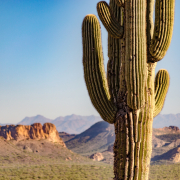Agrisolar Projects in Arizona Utilize American Indian Techniques
AgriSolar Clearinghouse partner Greg Barron-Gafford, a professor at the University of Arizona, is looking to indigenous knowledge to find solutions to modern agricultural challenges through agrivoltaics. Barron-Gafford is part of a research team that is using an agrisolar approach to find solutions for agricultural challenges like water shortages and direct sunlight on crops in the desert.
Intense, direct sunlight in the desert and water shortages are both issues addressed by the researchers at the Biosphere 2 lab and the Tumamoc Resilience Gardens, in Arizona. Traditional techniques used by the American Indian tribes in the area for more than 5,000 years may offer solutions, and the measures are being tested in these facilities.
“Instead of relying on tree shade, we’re underneath an energy producer that’s not competing for water,” Barron-Gafford recently told the Washington Post.
Vegetation on site at the Biosphere 2 location will plant crops under solar panels as well as the traditional rock berms and rock piles used by area tribes.
“We’ve had 5,000 years of farmers trying out different strategies for dealing with heat, drought and water scarcity,” Gary Nabhan, an ethnobotanist and agrarian activist working at the Biosphere 2 location in Arizona, explained to the Washington Post.
Pairing solar with appropriate agricultural land may address the issues faced by desert farmers by shading crops from the intense Arizona sunlight, which can provide a cool area for plants to flourish under solar panels. Solar panels, unlike shade trees, don’t need water which means crops don’t have to compete for the scarce resource.
Not relying on irrigation canals to nourish thirsty crops such as leafy greens, nuts, and fruits means there is less of an impact on the immense amount of water that has typically been drawn from aquifers and, in Arizona’s case, the Colorado River.
Not only does an agrivoltaic approach to these challenges mean less impact on water supply, but it allows communities to build energy resilience.
Read more about the Biosphere 2 operation here, and the Tumamoc Resilience Gardens here.



